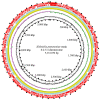First Report of Potentially Pathogenic Klebsiella pneumoniae from Serotype K2 in Mollusk Tegillarca granosa and Genetic Diversity of Klebsiella pneumoniae in 14 Species of Edible Aquatic Animals
- PMID: 36553800
- PMCID: PMC9778296
- DOI: 10.3390/foods11244058
First Report of Potentially Pathogenic Klebsiella pneumoniae from Serotype K2 in Mollusk Tegillarca granosa and Genetic Diversity of Klebsiella pneumoniae in 14 Species of Edible Aquatic Animals
Abstract
Klebsiella pneumoniae can cause serious pneumonitis in humans. The bacterium is also the common causative agent of hospital-acquired multidrug-resistant (MDR) infections. Here we for the first time reported the genetic diversity of K. pneumoniae strains in 14 species of edible aquatic animals sampled in the summer of 2018 and 2019 in Shanghai, China. Virulence-related genes were present in the K. pneumoniae strains (n = 94), including the entB (98.9%), mrkD (85.1%), fimH (50.0%), and ybtA (14.9%) strains. Resistance to sulfamethoxazole-trimethoprim was the most prevalent (52.1%), followed by chloramphenicol (31.9%), and tetracycline (27.7%), among the strains, wherein 34.0% had MDR phenotypes. Meanwhile, most strains were tolerant to heavy metals Cu2+ (96.8%), Cr3+ (96.8%), Zn2+ (91.5%), Pb2+ (89.4%), and Hg2+ (81.9%). Remarkably, a higher abundance of the bacterium was found in bottom-dwelling aquatic animals, among which mollusk Tegillarca granosa contained K. pneumoniae 8-2-5-4 isolate from serotype K2 (ST-2026). Genome features of the potentially pathogenic isolate were characterized. The enterobacterial repetitive intergenic consensus polymerase chain reaction (ERIC-PCR)−based genome fingerprinting classified the 94 K. pneumoniae strains into 76 ERIC genotypes with 63 singletons, demonstrating considerable genetic diversity in the strains. The findings of this study fill the gap in the risk assessment of K. pneumoniae in edible aquatic animals.
Keywords: Klebsiella pneumoniae; antibiotic resistance; aquatic animal; food safety; genetic diversity; heavy metal tolerance; virulence.
Conflict of interest statement
The authors declare no conflict of interest.
Figures





Similar articles
-
First Experimental Evidence for the Presence of Potentially Virulent Klebsiella oxytoca in 14 Species of Commonly Consumed Aquatic Animals, and Phenotyping and Genotyping of K. oxytoca Isolates.Antibiotics (Basel). 2021 Oct 11;10(10):1235. doi: 10.3390/antibiotics10101235. Antibiotics (Basel). 2021. PMID: 34680815 Free PMC article.
-
Virulence genes, efflux pumps, and molecular typing of Klebsiella pneumoniae isolates from North Iran.AMB Express. 2025 Mar 5;15(1):36. doi: 10.1186/s13568-025-01845-1. AMB Express. 2025. PMID: 40045145 Free PMC article.
-
The emergence of the hypervirulent Klebsiella pneumoniae (hvKp) strains among circulating clonal complex 147 (CC147) harbouring blaNDM/OXA-48 carbapenemases in a tertiary care center of Iran.Ann Clin Microbiol Antimicrob. 2020 Mar 31;19(1):12. doi: 10.1186/s12941-020-00349-z. Ann Clin Microbiol Antimicrob. 2020. PMID: 32234050 Free PMC article.
-
Virulence, Resistance, and Genomic Fingerprint Traits of Vibrio cholerae Isolated from 12 Species of Aquatic Products in Shanghai, China.Microb Drug Resist. 2020 Dec;26(12):1526-1539. doi: 10.1089/mdr.2020.0269. Epub 2020 Nov 6. Microb Drug Resist. 2020. PMID: 33156741 Free PMC article.
-
Hypervirulence and Multiresistance to Antibiotics in Klebsiella pneumoniae Strains Isolated from Patients with Hospital- and Community-Acquired Infections in a Mexican Medical Center.Microorganisms. 2022 Oct 16;10(10):2043. doi: 10.3390/microorganisms10102043. Microorganisms. 2022. PMID: 36296319 Free PMC article.
Cited by
-
A Duplex PCR Assay for Rapid Detection of Klebsiella pneumoniae and Chryseobacterium in Large Yellow Croaker Fish.Foodborne Pathog Dis. 2024 Aug;21(8):508-516. doi: 10.1089/fpd.2023.0149. Epub 2024 May 6. Foodborne Pathog Dis. 2024. PMID: 38708669 Free PMC article.
-
Effects of Seawater from Different Sea Areas on Abalone Gastrointestinal Microorganisms and Metabolites.Microorganisms. 2025 Apr 16;13(4):915. doi: 10.3390/microorganisms13040915. Microorganisms. 2025. PMID: 40284752 Free PMC article.
-
Genomic Characterization of Multidrug-Resistant and ESBL-Producing Klebsiella pneumoniae Isolated from Healthy Rabbits Intended for Human Consumption.Microorganisms. 2025 Aug 18;13(8):1931. doi: 10.3390/microorganisms13081931. Microorganisms. 2025. PMID: 40871435 Free PMC article.
-
Occurrence of carbapenem-resistant hypervirulent Klebsiella pneumoniae in oysters in Egypt: a significant public health issue.Ann Clin Microbiol Antimicrob. 2024 Jun 17;23(1):53. doi: 10.1186/s12941-024-00711-5. Ann Clin Microbiol Antimicrob. 2024. PMID: 38886796 Free PMC article.
References
-
- Holt K.E., Wertheim H., Zadoks R.N., Baker S., Whitehouse C.A., Dance D., Jenney A., Connor T.R., Hsu L.Y., Severin J., et al. Genomic analysis of diversity, population structure, virulence, and antimicrobial resistance in Klebsiella pneumoniae, an urgent threat to public health. Proc. Natl. Acad. Sci. USA. 2015;112:E3574–E3581. doi: 10.1073/pnas.1501049112. - DOI - PMC - PubMed
-
- Girometti N., Lewis R.E., Giannella M., Ambretti S., Bartoletti M., Tedeschi S., Tumietto F., Cristini F., Trapani F., Gaibani P., et al. Klebsiella pneumoniae bloodstream infection: Epidemiology and impact of inappropriate empirical therapy. Medicine. 2014;93:298–309. doi: 10.1097/MD.0000000000000111. - DOI - PMC - PubMed
-
- Friedlaender C. Ueber die Schizomyceten bei der acuten fibrösen Pneumonie. Archiv. Pathol. Anat. 1882;87:319–324. doi: 10.1007/BF01880516. - DOI
Grants and funding
LinkOut - more resources
Full Text Sources
Miscellaneous

